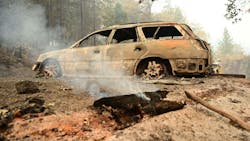Feds to Wildland Firefighters: Stop 'Let It Burn' Strategy
By Anita Chabria
Source Los Angeles Times
SACRAMENTO, CA—Facing criticism over its practice of monitoring some fires rather than quickly extinguishing them, the U.S. Forest Service has told its firefighters to stop using the strategy for now, to help prevent small blazes from growing into uncontrollable conflagrations.
The policy change came days after California and Western state politicians, including California Gov. Gavin Newsom, publicly challenged the “let it burn” practice in the wake of the Tamarack Fire. The criticism was detailed in a Los Angeles Times story on Sunday.
Instead of letting some naturally caused small blazes to burn, the agency’s priorities will shift this year, U.S. Forest Service Chief Randy Moore indicated to staff in a letter Monday. The focus, he said, will be on firefighter and public safety.
Moore, who took over as head of the agency last month, wrote that the 2021 fire season is “different from any before” and posed a “national crisis” that required the U.S. Forest Service to put on hold its mission to groom forestlands to make them more resilient to fires. Instead, he said, the agency will use its strained resources to protect lives and homes.
“We are in a ‘triage mode’ where our primary focus must be on fires that threaten communities and infrastructure,” Moore wrote.
In part to reintroduce fire to landscape after decades of suppression, the Forest Service for many years has allowed some small fires in secluded areas to burn. The Tamarack fire was one of those.
The fire began as a July 4 lightning strike on a single tree in the Mokelumne Wilderness, a remote area southeast of Sacramento. Forest officials decided to monitor it rather than attempt to put it out, a decision a spokeswoman said was based on scant resources and the remote location. But the blaze continued to grow, eventually consuming nearly 69,000 acres, destroying homes and causing mass evacuations. It is now 82% contained.
Speaking to President Joe Biden in a virtual meeting with other western states governors last week, Newsom pleaded for help changing the “culture” of the U.S. Forest Service when it comes to allowing fires to burn.
Newsom said the “wait and see” policy was the “elephant in the room” when it came to wildfires.
“You can’t just walk away, not with this climate, not with this drought, " he said earlier in the week while visiting areas of the Tamarack fire. “This is life and death, and we can’t just fight fires the way we did 20, 30, 40 years ago anymore.”
Newsom is scheduled to meet Wednesday with Moore and U.S. Agriculture Secretary Tom Vilsack at the burn scar of the 2020 August Complex in Northern California, the largest wildfire in California’s recorded history, to discuss how state and federal authorities can better work together on managing forests.
For decades, the federal agencies that manage national forests and grasslands have fallen far behind on reducing brush, dead trees and other “fuels” for wildfires, in part because of a lack of funding and environmental disputes. Attempts to use prescribed burns during wetter periods have sometimes been blocked by California air districts, concerned about smoke compounding existing air pollution.
Last year, California signed an agreement to increase the pace of preventative maintenance, such as thinning of forests, but that work remains unfunded on the federal side.
___
©2021 Los Angeles Times.
Visit at latimes.com.
Distributed by Tribune Content Agency, LLC.






